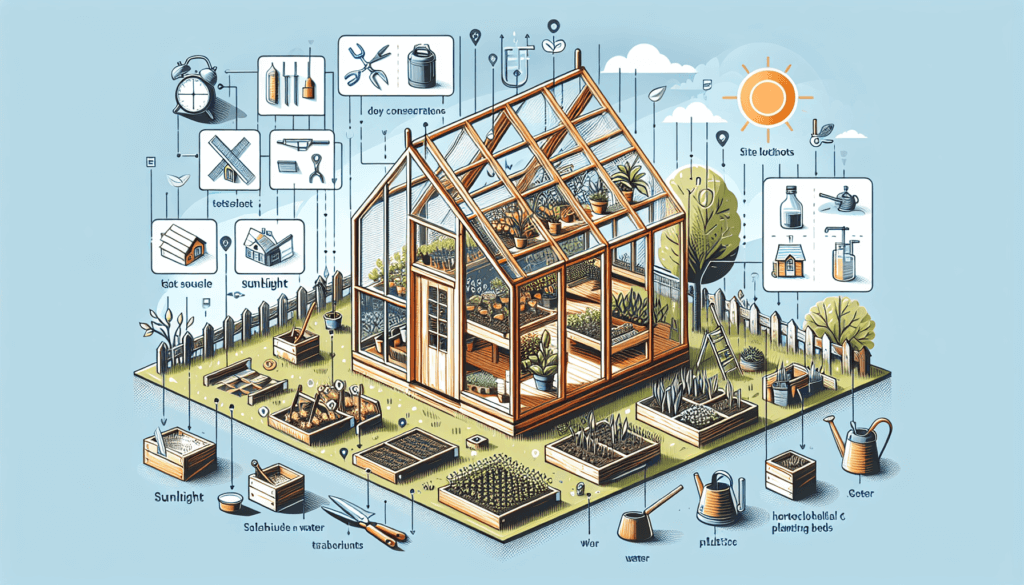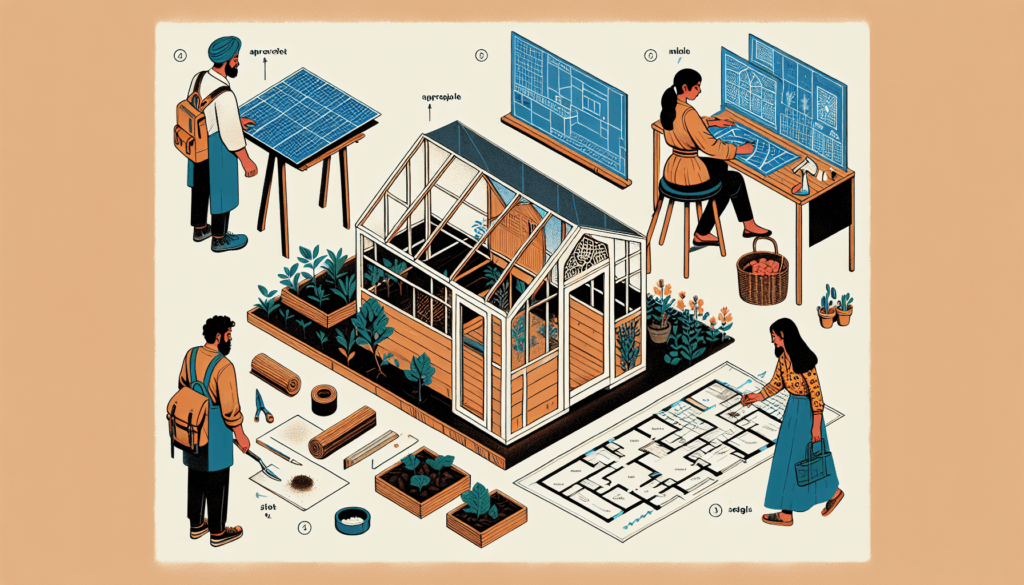So, you’ve decided to take your gardening game to the next level and build a greenhouse. Congratulations! A greenhouse can be a game-changer for any budding gardener, allowing you to cultivate a wide variety of plants regardless of the weather outside. Whether you have a green thumb or are just starting out, this beginner’s guide will provide you with all the essential information and tips you need to successfully build and maintain your own greenhouse. From choosing the right location to understanding the materials and tools required, we’ve got you covered every step of the way. Let’s get started on this exciting journey to creating your very own botanical haven!

Choosing the Right Location
Consider the Climate
When choosing a location for your greenhouse, it’s important to consider the climate of your area. Different plants thrive in different climates, so you’ll want to ensure that the location you choose can provide the ideal conditions for your plants to grow. If you live in an area with cold winters, you may need to consider insulating your greenhouse to retain heat. On the other hand, if you live in a hot climate, you might want to invest in shading or cooling systems to prevent your plants from overheating.
Find a Sunny Spot
One of the key factors in selecting the right location for your greenhouse is finding a spot that receives ample sunlight. Sunlight is essential for plant growth, so you’ll want to choose a location that can provide at least six to eight hours of direct sunlight each day. Avoid areas that are shaded by trees or buildings, as this can limit the amount of sunlight your plants receive. Additionally, consider the orientation of your greenhouse – south-facing locations tend to receive the most sunlight throughout the day.
Ensure Good Drainage
Proper drainage is crucial for maintaining a healthy greenhouse environment. If water accumulates around your plants, it can lead to root rot and other moisture-related issues. When selecting a location, make sure the ground has good natural drainage or consider implementing a drainage system if necessary. Avoid areas that are prone to flooding or where water tends to pool, as this can cause damage to both your plants and the structure of your greenhouse.
Check for Access to Water and Electricity
To successfully maintain your greenhouse, it’s important to have easy access to water and electricity. You’ll need a reliable water source for irrigation, as well as electricity for powering fans, lights, or other necessary equipment. Select a location near a water supply, such as a hose or irrigation system, to make watering your plants more convenient. As for electricity, ensure that the location you choose is easily accessible to power sources to avoid any complications in setting up electrical equipment.
Selecting the Type of Greenhouse
Lean-To Greenhouse
A lean-to greenhouse is a type of greenhouse that is attached to an existing structure, such as a wall or a building. This type of greenhouse is ideal for smaller spaces or for those who want to take advantage of an existing structure for added support and insulation. Lean-to greenhouses are often more cost-effective and easier to construct compared to other types of greenhouses. They can provide a convenient and compact space for your plants, utilizing the heat from the wall or building to help maintain the temperature inside the greenhouse.
Freestanding Greenhouse
A freestanding greenhouse is a standalone structure that is not attached to any existing building or wall. This type of greenhouse offers more flexibility in terms of its location and size. With a freestanding greenhouse, you have the option to position it wherever you have the most suitable conditions for your plants. It allows for better airflow and ventilation, as you have the freedom to choose the direction and orientation that best suits your needs. Keep in mind that a freestanding greenhouse may require additional heating and insulation compared to a lean-to greenhouse.
Attached Greenhouse
An attached greenhouse is similar to a lean-to greenhouse in that it is connected to an existing structure. However, unlike a lean-to greenhouse, an attached greenhouse is a separate structure that is built alongside the existing building or wall, rather than being directly attached to it. This type of greenhouse offers more space and versatility compared to a lean-to greenhouse, while still benefiting from the added support and insulation that comes with being attached to a structure.
Dome Greenhouse
A dome greenhouse, as the name suggests, has a rounded or dome-shaped design. This unique shape allows for efficient airflow and maximizes the use of space. Dome greenhouses are known for their excellent insulation properties, as the curved design helps to retain heat. They are often used in colder climates to provide optimal growing conditions for plants that require higher temperatures. Keep in mind that the construction of a dome greenhouse can be more challenging and may require specialized materials.
Window-Mounted Greenhouse
A window-mounted greenhouse is a smaller-scale greenhouse that is designed to fit directly onto a window. This type of greenhouse is ideal for those with limited space or who want to start small. Window-mounted greenhouses are often made of lightweight materials, making them easy to install and remove as needed. They provide a convenient way to grow a small selection of plants and herbs, without the need for a larger greenhouse structure.
Determining Greenhouse Size
Assess Your Needs
Before deciding on the size of your greenhouse, it’s important to assess your needs and goals. Consider the types of plants you plan to grow, as well as the quantity. Are you looking to start a small herb garden or do you have aspirations of growing a wide variety of fruits and vegetables? Take into account the space required for each plant, including their height, width, and potential growth. This will help you determine the size of the greenhouse that will best accommodate your needs.
Consider Available Space
Take a careful look at the available space on your property where you plan to build your greenhouse. Consider any existing structures or natural features that may impact the placement and size of your greenhouse. Measure the dimensions of the available space, taking into consideration any potential obstructions such as trees or utility lines. It’s essential to choose a greenhouse size that fits comfortably within the available space without overcrowding or compromising on functionality.
Factor in Future Expansion
While it’s important to select a greenhouse size that suits your current needs, it’s also wise to consider future expansion possibilities. Once you start gardening in a greenhouse, you may find yourself wanting to grow more plants or experimenting with new varieties. If you have the space and resources, it’s a good idea to plan for potential growth and expansion. This could involve building a greenhouse that can be easily extended or leaving space around the greenhouse for future expansion.
Choosing the Right Materials
Frame Materials
The frame of your greenhouse provides the structure and support for the entire building. Therefore, it’s crucial to select the right materials to ensure durability and longevity. Common greenhouse frame materials include wood, aluminum, galvanized steel, or PVC. Wood frames offer a natural and aesthetically pleasing option, but they require regular maintenance to protect against rot and warping. Aluminum frames are lightweight, rust-resistant, and easy to assemble. Galvanized steel frames offer excellent strength and durability, but may be more expensive. PVC frames are affordable and easy to work with, but they may not provide the same level of strength as other materials.
Covering Materials
The covering material for your greenhouse plays a significant role in providing insulation, light transmission, and protection for your plants. Common greenhouse covering materials include glass, polycarbonate panels, and polyethylene film. Glass offers excellent light transmission, durability, and a traditional aesthetic. However, it can be heavy and more susceptible to breakage. Polycarbonate panels are lightweight, durable, and provide good insulation properties. They are often used in colder climates where heat retention is essential. Polyethylene film is a cost-effective option that provides good light transmission, but it needs to be replaced periodically.
Insulation Materials
To ensure optimal growing conditions inside your greenhouse, proper insulation is essential. Insulation materials can help regulate the temperature and prevent heat loss. Common insulation materials include bubble wrap, fiberglass, or double-layered coverings. Bubble wrap can be hung inside the greenhouse walls to create an additional layer of insulation. Fiberglass insulation can be placed within the walls and roof to provide thermal efficiency. Double-layered coverings involve installing an inner and outer layer of covering material to trap air between the layers, providing insulation and reducing heat loss.

Preparing the Site
Clearing the Area
Before you start constructing your greenhouse, it’s essential to clear the area of any vegetation, debris, or obstructions. Remove any grass, weeds, or rocks that may interfere with the construction process. Clearing the area helps create a clean and stable foundation for your greenhouse.
Leveling the Ground
Once the area is cleared, it’s crucial to ensure that the ground is level. A level surface is necessary for proper construction and stability of the greenhouse. Use a leveling tool or a long, straight board to check for any unevenness in the ground. If necessary, add or remove soil to level the area before proceeding with the construction.
Building a Foundation
Building a foundation for your greenhouse is an important step in ensuring its stability and durability. The type of foundation you choose will depend on the size and type of greenhouse you are building. Common greenhouse foundations include concrete slabs, treated wood frames, or raised beds. The foundation needs to be secure and level to provide a solid base for the greenhouse structure.
Constructing the Frame
Assembling the Base
Start constructing the frame of your greenhouse by assembling the base. This may involve connecting the base rails or beams according to the instructions provided with your greenhouse kit or plans. Ensure that the base is level and securely fastened to the foundation.
Creating the Walls
Once the base is assembled, it’s time to create the walls of your greenhouse. This may involve attaching vertical beams or frames to the base, forming the structure of the walls. Follow the instructions provided to ensure proper alignment and stability. Consider adding additional support beams or diagonal bracing to strengthen the walls, especially for larger greenhouses or areas prone to strong winds.
Building the Roof
After the walls are in place, it’s time to construct the roof of your greenhouse. This may involve attaching roof beams or trusses to the top of the walls and connecting them securely. The roof frame should be designed to provide proper support and angle to accommodate the covering material you have chosen. Ensure that the roof is structurally sound and capable of withstanding the weight of potential snow or additional equipment such as ventilation systems.

Installing the Covering
Choosing the Right Method
Installing the covering for your greenhouse can be done using various methods, depending on the type of covering material you have chosen. Some covering materials may require specific installation techniques, such as glazing for glass or securing with clips for polycarbonate panels. Follow the manufacturer’s instructions or consult with a professional to ensure the correct installation method for your chosen covering material.
Installing Polycarbonate Panels
Polycarbonate panels are a popular choice for greenhouse coverings due to their durability and insulation properties. To install polycarbonate panels, start by measuring and cutting the panels to the appropriate size. Attach the panels to the greenhouse frame using a combination of screws, washers, or clips, as recommended by the manufacturer. Make sure the panels are properly aligned, overlapping, and securely fastened to create a watertight seal.
Using Polyethylene Film
Polyethylene film is a more affordable option for greenhouse coverings. To install polyethylene film, start by unrolling the film and draping it over the greenhouse frame. Secure the film to the frame using polyethylene film clips or staples, making sure to stretch the film taut to minimize wrinkles. Trim off any excess film and seal the edges to prevent drafts or leaks. Regularly inspect the film for any signs of wear or damage, as it may need to be replaced periodically.
Installing Glass Panes
Glass panes are a classic choice for greenhouse coverings. To install glass panes, begin by measuring and cutting the glass to fit the greenhouse frame. Attach the glass panes to the frame using glazing strips or clips, keeping them securely in place. Apply a suitable sealant or putty to create a weatherproof seal between the glass and the frame. Take care when working with glass to avoid breakage and injury, and consider wearing gloves and safety goggles for protection.
Adding Ventilation
Installing Windows
Windows are an essential component of greenhouse ventilation. They allow for natural airflow and help regulate temperature and humidity levels. When installing windows, ensure that they are positioned strategically to promote cross ventilation and airflow. Consider using windows with adjustable openings or vents to allow for manual control of the ventilation. Make sure the windows are securely attached and seal well to prevent drafts or water leaks.
Adding Vents
In addition to windows, adding vents to your greenhouse can further enhance ventilation and airflow. Vents can be installed in the roof or walls of the greenhouse and can be operated manually or automatically using a ventilation system. Automatic vents are especially useful for maintaining optimal temperature and humidity levels, as they open and close based on preset parameters. Ensure that the vents are properly sealed when closed to prevent air leakage or water intrusion.
Using Ventilation Fans
For more controlled and powerful ventilation, consider using ventilation fans in your greenhouse. Ventilation fans help to circulate air and remove excess heat and humidity. They can be installed in strategic locations, such as the walls or ceiling, to ensure proper airflow throughout the greenhouse. Choose fans that are appropriate for the size and requirements of your greenhouse, and consider using thermostatic controls to automatically adjust fan speed based on temperature.

Setting Up Irrigation and Watering Systems
Installing a Drip System
A drip irrigation system is an efficient way to provide water to your plants directly at their root zone. It involves a network of tubes with emitters that deliver a slow and steady supply of water to each plant. To install a drip system, lay the tubes along the rows or beds of your greenhouse, making sure to space the emitters according to the watering needs of your plants. Connect the tubes to a water source and install a timer or controller to automate the watering schedule.
Setting up a Sprinkler System
A sprinkler system is another option for greenhouse irrigation, especially for larger-scale operations. It involves overhead sprinklers that distribute water over a larger area. When setting up a sprinkler system, position the sprinkler heads strategically to ensure even coverage. Connect the system to a water source and install a timer or controller for automated watering. Be mindful of the water pressure and adjust the sprinkler heads accordingly to avoid excessive water runoff or uneven watering.
Adding a Watering System
In addition to an irrigation system, it’s essential to have a convenient watering system for hand-watering or filling watering cans. Consider setting up a water supply station within your greenhouse, equipped with a sink or faucet. This will make watering your plants more accessible and efficient, allowing you to easily refill watering cans or clean equipment.
Maintaining the Greenhouse
Regular Cleaning and Sanitizing
To ensure a healthy growing environment for your plants, it’s crucial to regularly clean and sanitize your greenhouse. Remove any debris, dead plants, or fallen leaves that can harbor pests or diseases. Sweep or hose down the floors and surfaces to remove dirt and dust. Disinfect the greenhouse periodically using products specifically designed for greenhouse sanitation to prevent the spread of diseases.
Pest and Weed Control
Pests and weeds can quickly become a problem in a greenhouse environment. Regularly inspect your plants for signs of pests or disease and take appropriate measures to control their spread. This may include using organic pest control methods, such as introducing beneficial insects or applying natural insecticides. Stay vigilant and promptly remove any weeds to prevent competition for resources and to maintain the health of your plants.
Monitoring Temperature and Humidity
Monitoring the temperature and humidity levels within your greenhouse is crucial for plant growth and health. Invest in a reliable thermometer and hygrometer to keep track of these factors. Adjust the ventilation, shading, or heating systems as necessary to maintain optimal conditions. Use shade cloth or blinds to regulate excessive heat, and consider using misting or humidification systems to increase humidity if needed.
Inspecting and Repairing Coverings
Regularly inspect the coverings of your greenhouse for any signs of wear, damage, or leaks. Repair or replace any damaged or worn-out materials promptly to ensure proper insulation and protection for your plants. This includes checking for cracks or gaps in glass panes, loose or torn polyethylene film, or damaged polycarbonate panels. Regular maintenance and repairs will help prolong the lifespan of your greenhouse and provide an optimal growing environment for your plants.
Building a greenhouse can be a rewarding and enjoyable experience for any gardener. By carefully considering the location, type, size, materials, and necessary maintenance, you can create a greenhouse that not only suits your needs but also provides an ideal environment for your plants to flourish. With proper planning and attention to detail, your greenhouse can become a haven for year-round gardening and a source of joy and fulfillment. So go ahead, start planning, and soon you’ll be on your way to building the greenhouse of your dreams!



